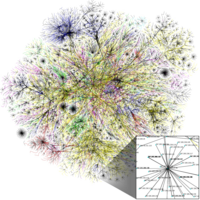
Photo from wikipedia
With the escalating demand for high speed, high reliability, low latency, low cost and ubiquitous connectivity, the telecommunications industry is entering a new era where the ultimate optimality of the… Click to show full abstract
With the escalating demand for high speed, high reliability, low latency, low cost and ubiquitous connectivity, the telecommunications industry is entering a new era where the ultimate optimality of the current wireline-wireless access network has to be achieved. Regarding the current wireline network paradigm, dominated by the copper-based digital subscriber lines (DSL) technology, multi-Gigabit data rate is the ambitious design objective at the customer end for the forthcoming ITU-T G.mgfast standard. In order to prepare for the new challenges in the era of total network convergence, both the wireline and the wireless community must be able to think beyond their respective conventions and learn from each other if necessary. Overall, the current DSL-based wireline network architecture is prone to the mutual interference resulting in far-end crosstalk (FEXT). The newly expanded 424/848 MHz spectrum of the ambitious G.mgfast project introduces far higher FEXT than that over the current 212/30 MHz G.fast/VDSL2 band. Additionally, the coexistence of multiple standards will also cause ‘alien’ FEXT. In these cases, using the plain zero forcing precoding (ZFP) will no longer attain a sufficiently high performance. However, as shown in the field of wireless communications, using lattice reduction as a signal space remapping technique significantly improves the performance of traditional multi-user detectors (MUD) and of the respective multi-user precoders (MUP). These promising techniques have largely remained unexploited in commercial wireless communications, due to their complexity in the face of the rapidly fluctuating wireless channels. In this survey, we present an overview of the state-of-the-art in wireline access network and an outlook for recent technological advances in the holistic ‘wireline + wireless’ access network in the context of network convergence, focusing on the dominant challenge of FEXT mitigation in future DSL networks. Against this background, we investigate both the family of linear precoding and of the Tomlinson-Harashima precoding (THP) schemes conceived for classic DSL. Furthermore, we present a tutorial on the family of lattice reduction aided MUPs, as well as quantifying their expected performances in realistic DSL scenarios. As a by-product, we also demonstrate the duality between MUP and MUD, in the hope that the fifty years’ history of MUD could be used to accelerate the development of efficient near-optimal MUPs for future DSL. Under the recommended operating conditions of the 212 MHz profile of G.fast, our benchmark comparisons indicate that the lattice reduction aided techniques are very powerful compared to conventional schemes. In particular, their good performances do not rely on optimized spectrum balancing, and they are also shown to be relatively robust against channel state information (CSI) estimation error, under the assumption of perfectly time-invariant DSL channels.
Journal Title: IEEE Access
Year Published: 2020
Link to full text (if available)
Share on Social Media: Sign Up to like & get
recommendations!